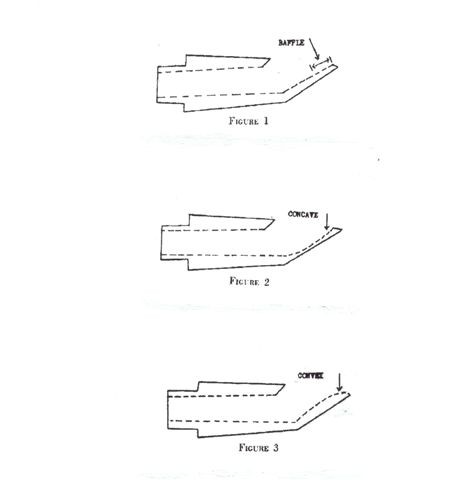
MOUTHPIECE REFACING AND CUSTOMIZING
Hand-facing a clarinet mouthpiece is a tedious and patience-demanding practice. As a practitioner, one discovers there are a number of ways of arriving at a satisfactory result, the most important being accuracy. Shoddy and sloppy work will never gain good results, and clients will become very scarce. It is important to remember that the bore, tone chamber and the material of the mouthpiece are as important to playability as the "lay" or "facing" - if not more. It appears that a good 'rod-rubber' mouthpiece is the material of choice, and the conception that the same results can be had on glass (chrystal), plastic (acrylic) or metal is just not true - close perhaps, but with diverse results.
THE BAFFLE
The baffle is the section of the mouthpiece which begins immediately below the tip-rail and extends down into the chamber to about three-eights of an inch. If not the most important part of the mouthpiece, it is one of the elements that enable the player to accurately voice and project the tone quality. Figure 1 shows the area of the baffle.
A. Low Baffle
The low baffle is concave (hollow) and curved. Figure 2. A dark tone is the quality produced with this type of baffle, and if it is too low, the result is a tone which sounds rather "tubby" or "stuffy" in quality. It doesn't project very well even though to the player, it sounds like a big, fat tone. Because of this lack of projection, it sounds - at a distance - weak and thin. For the majority of players it is too hard to blow, creating a back pressure causing too much resistance and making the reed feel very hard.
B. High Baffle
This is the exact opposite of the Low Baffle, being convex in shape. Figure 3. There is a noticeable roundness as it approaches the tip-rail of the mouthpiece. One of the characteristics of this mouthpiece is the edginess of the tone. Usually louder in dynamics, it is also thinner and rather nasal. Unless the tongue is kept in perfect position and the reed is really good, there is a strong tendency to "squeak." A reed with a really thin tip will squeak constantly. For best results, the tip of the reed should be thicker and the vamp or "heart" of the reed thinner. A high baffle compresses the air near the tip of the mouthpiece springing the reed away from the tip, thereby making the facing appear more open. On saxophone, the low notes will be difficult to emit.
C. A MODERATION OF A AND B
This baffle is neither too high nor too low, and is the type pictured in Figure 1. It facilitates a good sound and clean articulation in all registers. It projects well, and doesn't sound too bright nor dark. It provides the player with a feeling of well-being with his playing and allows for freedom of expression and phrasing. It is a known fact that if a player has to literally 'fight' the tone and control, his musical expression and overall musicianship is going to suffer. Diverting our attention from the musical to the mechanical makes playing the clarinet more difficult that is necessary.

THE COMMERCIAL TRAIL
For the average clarinetist, young/old, professional/non-professional, beginner/intermediate-advanced, there is the fine option of buying a very good mouthpiece manufactured by one of the many companies who are well know for their fine mouthpieces. Vandoren , one of the largest mouthpiece manufacturers - and well know for a wide selection of facings - has many variations of mouthpiece facings, and with expert help from a good teacher/clarinetist, the student most certainly will find one which will produce a fine tone and good articulation. Clark Fobes of San Francisco, is a fine mouthpiece maker, and can provide a very professional selection of excellent clarinet mouthpieces.